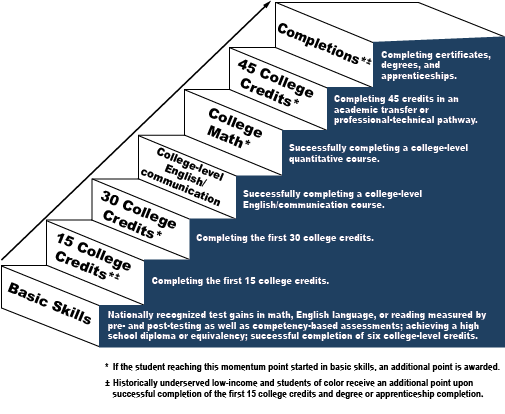Student Achievement Initiative
This page, or its linked-to content, may only be available to college system staff.
The Student Achievement Initiative (SAI) is the performance funding system for Washington state's system of community and technical colleges.
Colleges receive points, with funding attached, when students reach key academic momentum points, such as finishing college-level math, completing the first year of college, and earning a certificate or degree. Rigorous data analysis shows that students who achieve these momentum points are much more likely to earn a certificate or degree.
SAI represents a shift from funding colleges based on the number of students they enroll to also funding meaningful outcomes.
Contact
Summer Kenesson
Director, Policy Research
skenesson@sbctc.edu
360-704-4384
Purpose of the Student Achievement Initiative (SAI)
SAI improves public accountability by more accurately describing what students achieve from enrolling in our colleges each year. It also provides financial incentives to colleges for increasing student achievement.
Achievement Measures
The community and technical college system, in partnership with the Community College Research Center at Columbia University, identified key academic benchmarks that students must meet to successfully complete degrees and certificates. These achievement points are meaningful for all students across:
- Demographic characteristics (race, age, income, employment status).
- Academic program or entering skill levels (basic skills, remedial, workforce education, academic transfer).
- Intensity of enrollment (part-time or full-time enrollment).
- Type of institution attended (urban, rural, large, small, community college, technical college
The categories of achievement measures are:
- Building towards college-level skills (basic skills gains and transitioning from precollege coursework into college-level).
- First year retention (earning 15 then 30 college-level credits).
- Second year retention and becoming workforce or transfer ready (45 college credits).
- Completing college-level math and English/writing.
- Completions (degrees, high-value certificates, apprenticeship training).
Student Achievement Initiative Momentum Points

Colleges earn achievement points every time a student reaches a certain level of achievement. These levels of achievement are called momentum points because each achievement is likely to propel students to another achievement.
SAI momentum points work in succession. The steps are:
- Momentum points start with basic skills students. Colleges earn points when basic skills students make nationally recognized test gains in math, English language, or reading as measured by pre- and post-testing or competency-based assessments. Students also earn momentum points by earning a high school diploma or equivalency certificate as well as upon completion of six college-level credits.
- The next momentum points are completion of the first 15 and 30 college credits.
- The next momentum point is completion of five college-level credits in English or writing.
- The next momentum point is completion of five college-level math credits in computation, math or logic.
- The next momentum point is completion of 45 college credits in either an academic transfer or professional-technical pathway, which is one year.
- The final momentum point is completion of certificates, degrees and apprenticeships.
In addition, the state recognizes the achievement gaps of our historically underserved students and have followed best practice policy recommendations in performance-based funding by providing a focus on these populations. Basic Skills students, low-income, and students-of-color receive additional points when achieving certain milestones. These milestones include the first 15 college-level credits and completion of apprenticeship awards and associate degrees.
Funding
The SAI metrics make up 5 percent of the total state allocation. Colleges are funded based on their share of points in 3 categories: total points (less completions), points per student, and completions.
Reports and Data Tools
The SAI serves as the guiding framework for tracking and analyzing student progress and success for many initiatives. Several reports and data tools were built to address key policy areas around student success and to enable colleges to benchmark themselves against the rest of the Washington state community and technical college system.
SAI points
This report contains quarterly and annual point totals for all colleges as well as share calculations in accordance with the funding metrics of total points less completions, completions, and points per student.